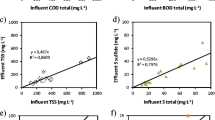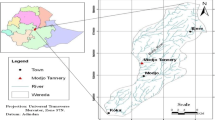Abstract
An integrated system, consisting of Up-flow Anaerobic Sludge Blanket (UASB)-duckweed-tilapia ponds was used for recovery of sewage nutrients and water recycling. A UASB reactor with 40 liter working volume was used as pre-treatment unit followed by a series of three duckweed ponds for nitrogen recovery. The treated effluent and duckweed biomass was used to feed fishponds stocked with Nile tilapia (Oreochromis niloticus). The UASB reactor was fed with raw, domestic sewage at 6 h hydraulic retention time. The three duckweed ponds were stocked with Lemna gibba and fed with UASB effluent at 15 days hydraulic retention time. Nitrogen recovery from UASB effluent via duckweed biomass represented 81% of total nitrogen removal and 46.5% from the total nitrogen input to the system. In subsequent fishponds the nitrogen recovery from duckweed as fish feed was in the range of 13.4–20%. This nitrogen in fish biomass represented 10.6–11.5 g N from the total nitrogen in the raw sewage fed to the UASB reactor. The growth performance of tilapia (Oreochromis niloticus) showed specific growth rates (SGR) in the range of 0.53–0.97. The range of feed conversion ratio (FCR) and protein efficiency ratio (PER) were 1.2–2.2 and 2.1–2.28, respectively. The results of the experiments showed total fish yield and net fish yield in the range of 17–22.8 ton/ha/y and 11.8–15.7 ton/ha/y respectively. In conclusion UASB-duckweed-tilapia ponds provide marketable by-products in the form of duckweed and fish protein, which represent a cost recovery for sewage treatment.
Similar content being viewed by others
References
Alaerts, G.J., Mahbubar, M.D.R., and Kelderman, P.: 1996, ‘Performance Analysis of a Full-Scale Duckweed-Covered Sewage Lagoon,’ Water Research 30(4), 843–852.
Albert, A.: 1973, Selective Toxicity. Chapman and Hall, London, pp. 597.
Al-Nozaily, F., Alaerts, G., and veenstra, S.: 2000, ‘Performance of Duckweed-Covered Sewage Lagoon. 2. Nitrogen and Phosphorus Balance and Plant Productivity,’ Water Research 34(10), 2734–2741.
APHA, 1998.: Standard Methods for the Examination of Water and Wastewater, 20th edn., American Public Health Association, Washington.
Anuradha, S. and Subburam, V.: 1995, ‘Role of Sewage Bacteria in Methemoglobin Formation in Cyprinus Carpio Exposed to Nitrate,’ Journal of Environmental Biology 16(2), 175–179.
Azim, M.E. and Wahab, M.A.: 2003, ‘Development of a Duckweed-Fed Carp Polyculture System in Bangladesh,’ Aquaculture 218, 425–438.
Basudha, C. and Vishwanath, W.: 1997, ‘Formulated Feed Based on Aquatic Weed Azolla and Fishmeal for Rearing carp Osteobrama Belangeri (Valenciennes),’ Journal of Aquaculture in the Tropics 12, 155–164.
Blier, R., Laliberte, G., and de la Noue, J.: 1995, ‘Tertiary Treatment of Cheese Factory Anaerobic Effluent with Phormidium Bohneri and Micractinium Puspillum,’ Bioresource Technology 22, 151–155.
Boniardi, N., Vatta, G., Rota, R., Nano, G., and Carra, S.: 1994, ‘Removal of Water Pollutants by Lemna gibba,’ The chemical Engireering Journal 54, 41–48.
Bunch, E.C. and Bejerano, I.: 1997, ‘The Effect of Environmental Factors on the Susceptibility of Hybrid Tilapia Oreochromis Niloticus X Oreochromis Aureus to Streptoccosis,’ Bamidgeh 49(2), 67–76.
Canario, A.V.M., Condeca, J., and Power, D.M.: 1998, ‘The Effect of Stocking Density on Growth in the Gilthead Sea Bream, Sparus Aurata (L.),’ Aquaculture Research 29, 177–181.
Culley Jr. D.D. and Epps E.A.: 1973, ‘Use of Duckweed for Waste Treatment and Animal Feed,’ Journal of Water Pollution Control Federation 45(2), 337–347.
Dewedar, A. and Bahgat, M.: 1995, ‘Fate of Faecal Coliform Bacteria in a Wastewater Retention Reservoir Containing Lemna Gibba L,’ Water Research 29(11), 2598–2600.
Dixo, N.G.H., Gambrill, M.P., Catunda, P.F.C., and van Haandel, A.C.: 1995, ‘Removal of Pathogenic Organisms from the Effluent of an Up Flow Anaerobic Digester using Waste Stabilisation Ponds,’ Water Science Technology 31(12), 275–284.
Draaijer, H., Maas, J.A.W., Schaapman, J.E., and Khan, A.: 1992, ‘Performance of the 5MLD UASB Reactor for Sewage Treatment at Kanpur, India,’ Water Science Technology 25(7), 123–133.
Edwards, P., Kaewpaitoon, K., Little, D.C., and Siripandh, N.: 1994, ‘An Assessment of the Role of Buffalo Manure for Pond Culture of Tilapia. II: Field Trial,’ Aquaculture 126, 97–106.
El-Hamouri, B., Jellal, J., Outabiht, H., Nebri, B., Khallayoune, K., Benkerroum, A., Hajli, A., and Firadi, R.: 1995, ‘The Performance of a High-Rate Algal Pond in the Moroccan Climate,’ Water Science Technology 31(12), 67–74.
El-Sayed, A.F.M.: 1992, ‘Effects of Substituting Fishmeal with Azolla Pinnata in Practical Diets for Fingerling and Adult Nile Tilapia, Oreochromis Niloticus L,’ Aquaculture and Fisheries Management 23, 167–173.
Emerson, K.R., Russo, R.C., Lund, R.E., and Thurston, R.V.: 1975, Aquous Ammonia Equilibrium Calculations: Effect of pH,’ Journal of the Fisheries Research Board of Canada 32, 2377–2383.
Ennabili, A., Ater, M. and Radoux, M.: 1998, Biomass Production and NPK Retention in Macrophytes Drom Wetlands of the Tingitan Peninsula,’ Aquatic Botany 62, 45–56.
Fallowfield, H. J., Cromar, N. J., and Evison, L. M.: 1996, ‘Coliform Die-Off Rate Constants in a High-Rate Algal Pond and the Effect of Operational and Environmental Variables,’ Water Science Technology 34(11), 141–147.
FAO, 2001, Aquaculture in the Third Millennium, Technical Proceedings of the Conference on Aquaculture in the Third Millennium, R.P. Subasinghe, P. Bueno, M.J. Phillips, G. Hough, S.E. McGladdery and J.R. Arthur (eds.), Bangkok, Thailand, 20–25 February 2000, NACA, Bangkok and FAO, Rome.
Fernandez, A., Tejedor, C., and Chodi, A.: 1992, ‘Effect of Different Factors on the Die-Off of Faecal Bacteria in a Stabilization Pond Purification Plant,’ Water Research 26(8), 1093–1098.
Gaigher, I.G., Porath, D., and Granoth, G.: 1984, ‘Evaluation of Duckweed (Lemna gibba) as Feed for Tilapia (Oreochromis Niloticus × Oreochromis Aureus) in a Recirculating Unit,’ Aquaculture 41, 235–244.
Gijzen, H.J.: 2001, ‘Anaerobes, Aerobes and Phototrophs: a Wining Team for Wastewater Management,’ Water Science Technology 44(8), 123–132.
Gijzen, H.J.: 2002, ‘Anaerobic Digestion for Sustainable Development: A Natural Approach,’ Water Science Technology 45(10), 321–328.
Gomes, E.F., Rema, P., Gouveia, A., and Teles, A.O.: 1995, ‘Replacement of Fishmeal by Plant Proteins in Diets for Rainbow Trout (Oncorehynchus Mykiss): Effect of Quality of Fishmeal Based Control Diets on Digestibility and Nutrient Balances,’ Water Science Technology 31(10), 205–211.
Gosh, C., Rrijns, I., and Lettinga, G. 1999, ‘Performance of Silver Carp (Hypophthalmicthys Molitrix) Dominated Integrated Post Treatment System for Purification of Municipal Wastewater in a Temperate Climate,’ Bioresource Techology 69, 255–262.
Hammouda, O., Gaber, A., and Abdel-Hameed, M. S.: 1995, ‘Assessment of the Effectiveness of Treatment of Wastewater-Contaminated Aquatic Systems with Lemna Gibba,’ Enzyme and Microbial Techology 17, 317–323.
Hargreaves, J.A.: 1998, ‘Nitrogen Biogeochemistry of Aquaculture Ponds,’ Aquaculture 166, 181–212.
Hassan, M.S. and Edwards, P.: 1992, ‘Evaluation of Duckweed (Lemna Perpusilla and Spirodela Polyrrhiza) as Feed for Nile Tilapia (Oreochromis Niloticus),’ Aquaculture 104, 315–326.
Keke, I.R., Ofajekwu, C.P, Ufodike, E.B., and Asala, G.N.: 1994, ‘The Effect of Partial Substitution of Groundnut Cake by Water Hyacinth (Eichhornia Crassipes) on Growth and Food Utilisation in the Nile Tilapia, Oreochromis Niloticus (L.),’ Acta Hydrobiologica 36(2), 235–244.
Korner, S. and Vermaat, J. E.: 1998, ‘The Relative Importance of Lemna Gibba L., Bacteria and Algae for Nitrogen and Phosphorous Removal in Duckweed-Covered Domestic Wastewater,’ Water Research 33(12), 3651–3661.
Mara, D.D., Edwards, P., Clark, D., and Mills, S.W.: 1993, ‘A Rational Approach to the Design of Wastewater-Fed Fishponds,’ Water Research 27(12), 1797–1799
Mbahinzireki, G.B., Dabrowski, K., Lee K.J., El-Saidy, D., and Wisner, E.R.: 2001, ‘Growth, Feed Utilisation and Body Composition of Tilapia (Oreochromis sp.) fed with Cottonseed Meal-Based Diets in a Recirculation System,’ Aquaculture Nutrition 7, 189–200.
Middleton, T.F., Fekert, P.R., Boyd, L.C., Daniels, H.V., and Gallagher, M.L.: 2001, ‘An Evaluation of Co-Extruded Poultry Silage and Culled Jewel Sweet Potatoes as a Feed Ingredient for Hybrid Tilapia (Oreochromis Niloticus × Oreochromis Mossambicus),’ Aquaculture 198, 269–280.
Nasr, F.A., El-Shafai, S.A., and Abo-Hegab, S.: 1998, ‘Suitability of Treated Domestic Wastewater for Raising Oreochromis Niloticus,’ Egyptian Journal of Zoology 31, 81–94.
Oron, G., Porath, D., and Jansen, H.: 1987, ‘Performance of Duckweed Species Lemna Gibba on Municipal Wastewater Effluent Renovation and Protein Production,’ Biotechnology Bioengineering XXIX, 258–268.
Oron, G. and Willers, H.: 1989, ‘Effect of Wastes Quality on Treatment Efficient with Duckweed,’ Water Science Technology 21, 639–645.
Papoutsoglou, S.E. and Tziha, G.: 1996, ‘Blue Tilapia (Oreochromis Aureus) Growth Rate in Relation to Dissolved Oxygen Concentration Under Re-Circulated Water Conditions,’ Aquaculture Engineering 15(3), 181–192.
Pillay, T.V.R.: 1992, Aquaculture and the Environment, 1st edn., University Press, Cambridge.
Rangeby, M., Johansson, P., and Pernrup, M.: 1996, ‘Removal of Faecal Coliform in a Wastewater Stabilization Pond System in Mindelo, Cape Verde,’ Water Science Technology 34(11), 149–157.
Render, B.D. and Stickney, R.R.: 1979, ‘Acclimatisation to Ammonia by Tilapia Aureus,’ Transaction of the American Fisheries Society 108, 383–388.
Rusoff, L.L., Blakeney, Jr., E.W., and Culley, Jr., D.D.: 1980, ‘Duckweed (Lemnaceae Family): A Potential Source of Protein and Amino Acids,’ Journal of Agriculture and Food Chemistry 28, 848– 850.
Schoore, J.E., Simco, B.A., and Davis, K.B.: 1995, ‘Responses of Blue Catfish and Channel Catfish to Environmental Nitrite,’ Journal of Aquatic Animal Health 7, 304–311.
Seghezzo, L., Zeeman, G., van Lier, J.B. Hamelers, H.V.M., and Lettinga, G.: 1998, ‘A Review: The Anaerobic Treatment of Sewage in UASB and EGSB Reactors,’ Bioresource Techology 65, 175– 190.
Silva, S.A., de Oliveira, R., Soares, J., Mara, D.D., and Pearson, H.W.: 1995, ‘Nitrogen Removal in Pond Systems with Different Configurations and Geometries,’ Trans. Ame. Fish. Soc. 31(12), 321–330.
Singh, K.S., Harada, H., and Viraraghavan, T.: 1996, ‘Low-Strength Wastewater Treatment by an UASB-Reactor,’ Bioresource Technology 55, 187–194.
Skillicorn, P., Spira, W., and Journey, W.: 1993, Duckweed Aquaculture: A New Aquatic Farming System for Developing Countries. The International Bank for Reconstruction and Development/The World Bank, Washington DC., pp. 76.
Smith, M.D. and Moelyowati, I.: 2001, ‘Duckweed Based Wastewater Treatment (DWWT): Design Guidelines for Hot Climates,’ Transaction of the American Fisheries Society 43(11), 291–299.
Tacon, A.G.J., Phillips, M.J., and Barg, U.C.: 1995, ‘Aquaculture Feeds and the Environment: The Asian Experience,’ Water Science Technology 31(10), 41–59.
UNEP: 2002’, State of the Environment and Policy Retrospective: 1972–2002’. in Production team of UNEP (ed.), Global Environment Outlook 3 Past, Present and Future Perspectives, UNEP, London, UK.
Van der Steen, P., Brenner, A., and Oron, G.: 1998, ‘An Integrated Duckweed and Algae Pond System for Nitrogen Removal and Renovation,’ Water Science Technology 38(1), 335–343.
Van der Steen, P., Brenner, A., Shabtai, Y., and Oron, G.: 2000, ‘Effect of Environmental Conditions on Faecal Coliform Decay in Post-Treatment of UASB-Reactor Effluent,’ Water Science Technology 42(10–11), 111–118.
Vermaat, J.E. and Hanif, M.K.: 1998, ‘Performance of Common Duckweed Species (Lemna Gibba) and the Water Fern Azolla Filiculoides on Different Types of Wastewater,’ Water Research 32(9), 2569–2576.
Victor, P.: 1993, ‘Growth Response of Nile Tilapia to Cow Manure and Supplemental Feed in Earthen Ponds,’ Revue d’Hydrobiologie Tropicale 26(2), 153–160.
Vieira, S.M.M., Carvalho, J.L., Barijan, F.P.O., and Rech, C.M.: 1994, Application of the UASB Technology for Sewage Treatment in a Small Community at Sumare, SaoPaulo State,’ Water Science Technology 30(12), 203–210.
Wahab, M.A., Azim, M.E., Mahmud, A.A., Kohinoor, A.H.M., and Haque, M.M.: 2001, ‘Optimisation of Stocking Density of Thai Silver Barb (Barbodes Gonionotus Bleeker) in the Duckweed-Fed Four Species Polyculture System,’ Bangladesh Journal of Fisheries Research 5(1), 13–21.
Wallace, J.S. and Gregory, P.J.: 2002, ‘Water Resources and Their use in Food Production Systems,’ Aquatic Science 64(4), 363–375.
WHO and UNICEF: 2000, Global Water Supply and Sanitation Assessment 2000. Report, pp. 80.
Woo, N.Y.S. and Chiu, S.F.: 1995, ‘Effect of Nitrite Exposure on Hematological Parameters and Blood Respiratory Properties in the Sea Bass Lates Calcarifer,’ Environmental Toxicology and Water Quality 10, 259–266.
Zaher, M., Hoo, M.E., Begum, M.N., and Bhuyan, A.K.M.A.: 1995, ‘Suitability of Duckweed, Lemna Minor as an Ingredient in the Feed of Tilapia, Oreochromis Niloticus,’ Bangladesh Journal of Zoology 23(1), 7–12.
Zimmo, O.R., Al-Saed, R., and Gijzen: 2000, ‘Comparison between Algae-Based and Duckweed-Based Wastewater Treatment: Differences in Environmental Conditions and Nitrogen Transformations,’ Water Science Technology 42(10–11), 215–222.
Author information
Authors and Affiliations
Corresponding author
Rights and permissions
About this article
Cite this article
El-Shafai, S.A., El-Gohary, F.A., Naser, F.A. et al. Nitrogen recovery in an integrated system for wastewater treatment and tilapia production. Environmentalist 27, 287–302 (2007). https://doi.org/10.1007/s10669-007-9005-z
Published:
Issue Date:
DOI: https://doi.org/10.1007/s10669-007-9005-z




